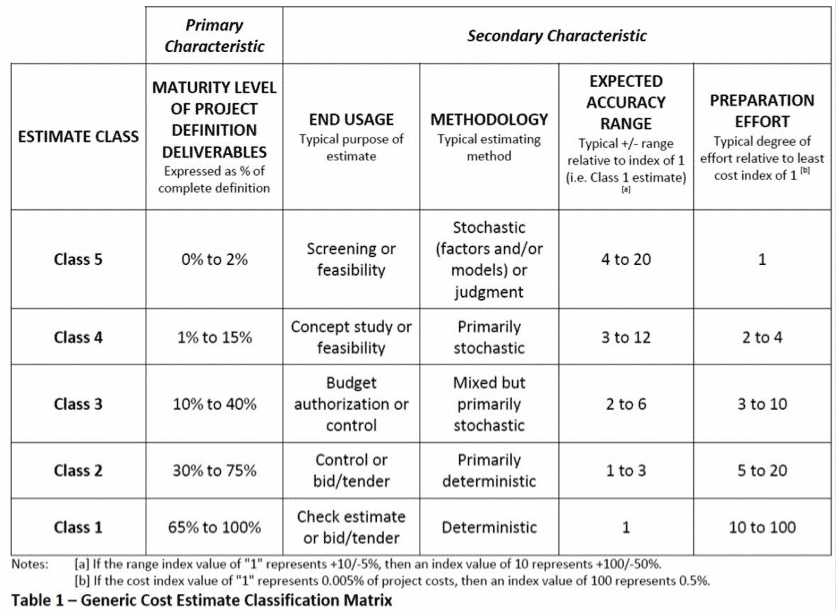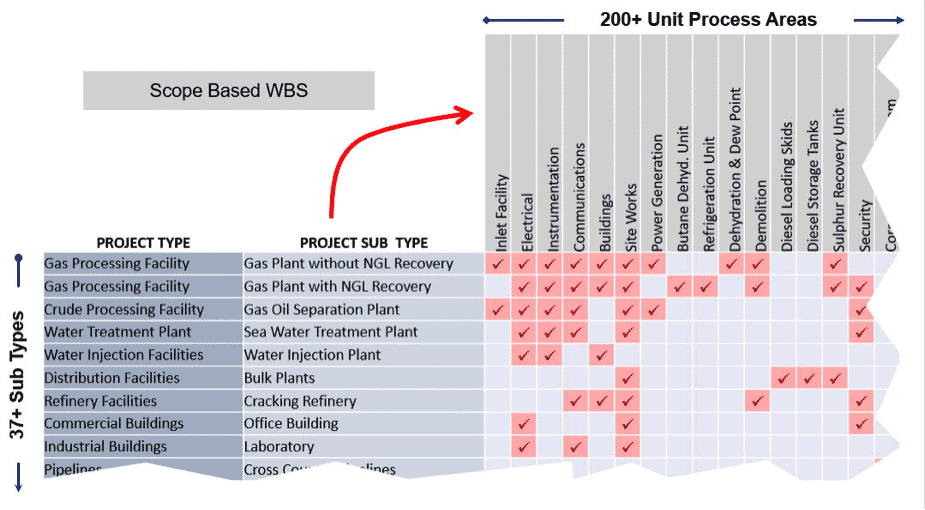How can you increase core-estimating maturity for Owner companies and improve project performance and increased capital efficiency in today’s construction industry?
Introduction
Owners rely on cost estimates to perform an economic analysis of the return on their capital investments or capital expenditures (CAPEX). Estimates are critical to early planning and de-risking of project budgets developed during project authorization.
When Owner companies place little emphasis on the quality of their core estimating capabilities, they often face perilous challenges during project execution stages as a result of poorly developed estimates.
Too often, Owners under appreciate or poorly align their estimating function during critical front-end, project definition and authorization project stages. As a result, they suffer the predictable consequences of poorly developed, overly biased cost estimates due to little attention to building strong and resilient internal estimating organizations.
Thus, for Owners, core estimating is a critical competency that must support all project stages with properly resourced estimating organizations, aligned processes, strong estimator competencies, sound estimating methods, a treasure trove of well-organized historical data and estimating systems which are well integrated with project controls and project management systems.
How
Estimating Relates to Accuracy and Completeness of Scope
Estimating is a process used to predict the future cost of a project. Across all industries and types of projects, estimators, in their preparation of estimates, are always looking to minimize the uncertainty of their estimates by utilizing as high a quality scope definition as soon as possible as an input to estimate preparation.
Thus, the quality and accuracy of an estimate depends on the completeness of the project scope. This scope forms the basis for estimate classification and estimate accuracy. The more incomplete the project scope, the wider the accuracy of the estimate. The more concise and complete the scope that is used, the narrower the accuracy of the estimate.
Moreover, estimating is considered a watershed activity, where many times, the cost estimate will lead to changes in scope or project plans as part of the development and review of various project alternatives.
In fact, the estimating process can be viewed as part of the scope definition process because of the iterative exchange between cost and scope which are deeply intertwined in the development of projects in their early stages. This is especially true when combined with value engineering and constructability reviews during early project development.
The Importance of Estimates for
Improved Project Planning
The quality and completeness of planning drives project performance. Estimating is a crucial part of superior planning. More accurate estimates improve capital project and capital expenditure (CAPEX) decision-making, leading to enhanced capital investment performance.
These steps will close common performance gaps related to the inferior project and portfolio planning:
1. An estimate classification system is essential for core estimating. It sets critical parameters for completeness of scope and the resulting estimate accuracy. Owners should deploy and enforce an effective Estimate Classification System based on the maturity of supporting deliverables. The AACE Estimate Classification and recommended practices are an excellent resource for developing a scope-based method for validation, and this classification system is available in most industries.
2. Enhance project definition by deploying a combination of the Construction Industry Institute’s (CII) Project Definition Rating Index (PDRI) for completeness/quality of deliverables together with estimate classification standards.

AACE Estimate Classification
3. Include value engineering and constructability reviews, and strong estimating participation in defining the deliverables required to support each estimate class.
4. Integrate estimate and schedule development to support the control budget and project execution.
5. Develop and use a standard, scope-based WBS classification system. Utilized scope based WBS together with a standard code-of-accounts that are integrated with other coding schemes for the purchase of materials, contract schedule of values, labor trade and equipment rates, general ledger accounts for project accounting and asset information for operations.
6. Develop a mature and broad array of estimating methods (e.g., parametric, capacity based, conceptual quantity-based assemblies, and bottoms-up)

Scope Based WBS
Establish Risk Management Capabilities
“Systemic risks include how mature and bias a project system is, how well that systems defines and manages the scope, and the degree of development” (Hollmann, John, “Project Risk Quantification”, Probabilistic Publishing, 2016).
Thus, poorly considered estimating, will be an inherent systemic risk to any owner. Limiting risks is a critical consideration for any project system.
Strong estimating organizations provide a basis for project risk management (scope/cost/schedule), which drives effective identification and assessment of project cost/schedule uncertainty resulting in improved contingency (and/or reserve) determination.
Effective risk management enhances decision-making regarding the prioritization of risk mitigation plans. This ensures improved prediction of material quantities, installation costs, indirect costs, etc. based on an evaluation of inherent and potential uncertainty.
Owner Core Estimating Organizations Require a Level of Independence or Autonomy
Strong core estimating provides for unbiased, accurate and repeatable estimates which in turn demands organizational credibility, trust and transparency. This often requires a step–up in organizational commitment in terms of resources, organizational maturity, and estimating methods , and tools.
It also requires discernment between the role of project controls, estimating for project controls and core estimating for proper role alignment in each project stage and project stage requirement.
C-Level executives need to have credible, accurate estimates endorsed by a corporate estimating authority prior to or coinciding with project authorization.
The Director of Estimating can ensure planning and authorization estimates are accurate to support corporate goals and objectives for asset investments and planning. Therefore, to reduce bias, estimating managers must possess equal or higher organizational clout as Project Managers. Proper organizational alignment will provide the cover necessary to clearly disclose project risks to management when evaluating estimate accuracy and establishing contingency and/or reserves.
Moreover, estimator independence allows estimators to report deviations from the required estimate classification for any given project stage and to identify a lack of compliance to estimate classification standards.
Project Managers need to ensure support of estimators to prepare unbiased estimates properly and according to estimate classification standards. C-Level management sets the bar by unmistakably endorsing estimate classification and the recommendations of estimating managers.
A strong independent core estimating organization will have the ability to provide fair market cost estimates (check estimates) for contractor bid evaluations and change orders. To guard against low-ball contractor bids, estimating sets hypothetical quantities for a contract’s schedule of work unit rates (WUR) for scope changes.
With autonomy comes tighter integration with the supply chain. Tighter integration with supply chain allows estimating data for owner-purchased materials and helps the supply chain manage procurement. The aggregation of multiple project estimates in any given CAPEX plan enables strategic purchasing to occur for commonly used materials across many projects.
The Importance of Benchmarking
Estimate accuracy and validation are intertwined. Both need historical data analysis and benchmarking to enable effectiveness of estimate preparation and validation. Benchmarking includes categorization of estimates and estimate components.
Common categorization includes but is not limited to project type or category, scope, region, business line, size, delivery method, contract type, equipment, material type, activity, trade or code-of-account, cost, schedule, procurement, etc.
Benchmarking data (and benchmarking systems) provide support to estimating methods. Thus, benchmarking can be used together with estimate development. Estimators can check their estimates during estimate development and use benchmarking in their estimate basis to support their cost estimates to end-users.
Strong Estimating drives the quality and completeness of the Project Execution Plan
Alignment is critical to project execution. Estimating is the gate between the Project Execution Plan (PEP) and the authorization estimate (ultimately the control budget).
A poorly-developed PEP reduces project stakeholder alignment, results in low estimate accuracy at authorization, reduces integration with supply chain, results in poor contract bid slate development and inability to properly validate contractor technical and commercial bids.
Missing or incomplete project execution plans will often precipitate failure in later project stages especially when they are prepared with insufficient rigor and proper disclosure to organizational stakeholders.
More accurate and more consistently-structured authorization estimates are a result of improved project planning and well-prepared PEP’s – where problems get addressed early while there is still time for intervention and corrective action. This translates to improved project certainty during execution, less change management, and improved performance.
With reliable and robust estimating processes based on well-prepared project execution plans, controlling the project becomes a payoff based on a natural progression rather than an adventure of reactive, fragmented and lagging efforts on the road to project failure.
Why should Owner companies evaluate their core estimating work processes?
In general, for many of the things that “go wrong” on a project, many will be traced back to gaps in the estimating process and will surface later in the project cycle. Here are several areas where Owners gain value from strong estimating organizations.
- Better planning estimates are a driver for capital efficiency: Future project success is better assured by more accurate estimates. More accurate estimates depend on the quality of the scope. Thus, improved estimates for CAPEX plans enable more effective utilization of capital dollars along with improved investment performance.
- Improved authorization estimates yield fewer surprises during EPC project stages, thus lowering change order activity and reducing uncertainty.
- During the preparation of estimates for project authorization, estimators often catch missing scope items. This information is often lost due to poor work process and organizational alignment. This occurs when estimators account for the missing scope in the estimate (and basis of estimate), but the project scope documents which flow into contracts are not updated to reflect what the estimator uncovers. The missing scope crops up later in change orders (or claims) and many times will drive out-of-sequence activities that disrupts project performance.
- Estimating is a force multiplier for project success and best estimating practices are a force multiplier for Supply Chain. The reciprocal is also true with estimating access to purchase orders and quantified contract data in the form of contracts and bids.
- Strong estimating organizations drive contract alignment. Estimates feed a quantity-based contract schedule of values, and benchmarking helps evaluate contractor and project performance on similar work.
Conclusion
As a result of proper estimating, organizational alignment, and increased accuracy, CAPEX planning has greater precision resulting in improved capital investment decision-making. Owners who deploy a scope-based WBS and comprehensive data integration, drive quantity-based progress measurement and project controls throughout each project execution and hand-over stages.
Authorization estimates which are more accurate, use an estimate classification system that drives better support for project risk management. More demand for increased project risk management results in more accurate estimates.
Authorization estimates which are based on well-prepared and rigorous project execution plans, stand a much-improved chance for project success and contractor alignment through better enabled bid-slate development.
When benchmarking is deployed with well-organized and categorized information and retrieval systems, historical data is fed back into estimating as a result of following industry and estimating best practices.
It is therefore imperative that Owners take an honest look at their core estimating maturity and employ sound principles to improve critical competency to support all project stages. This includes well resourced estimating organizations, aligned processes, superior estimator competencies and estimating methods.
Moreover, the importance of estimating systems which are integrated with project controls and project management systems is essential to complete the basic requirements of strong core estimating for owner companies.
About the Author, Fred Wellman

Fred Wellman is an Industry Consultant with 35+ years of experience in assisting Clients in deploying business strategies which maximize the effectiveness of their capital project system, close process gaps and reduce or eliminate systemic risks which attack project NPV and trigger high organizational pain.
Connect with Fred via LinkedIn.


















